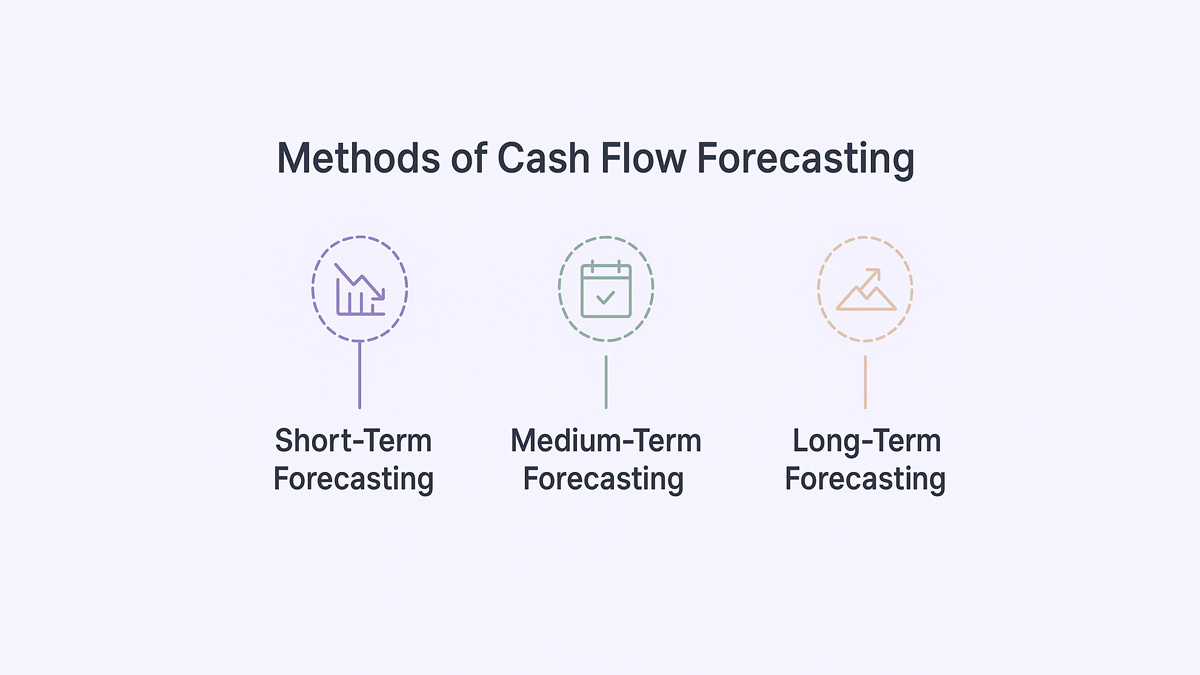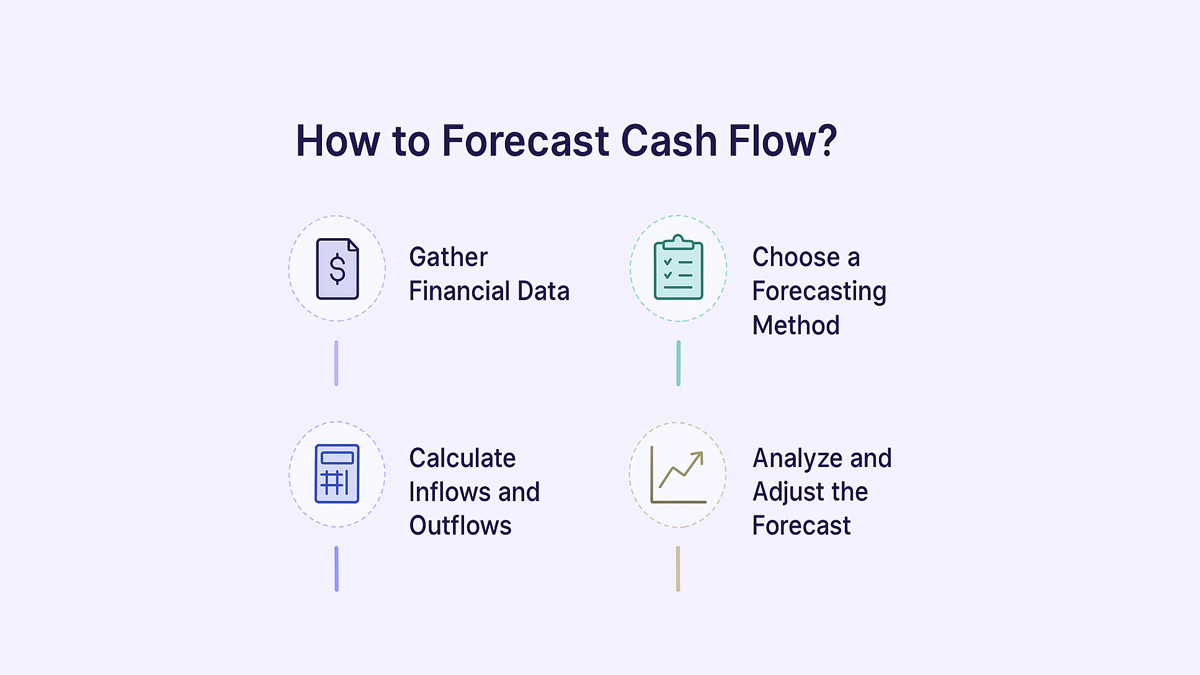

A Complete Guide to Cash Flow Forecasting

A Complete Guide to Cash Flow Forecasting
Master cash flow forecasting with practical tips, tools, and methods to manage liquidity and avoid cash shortfalls.


Running out of cash doesn’t always mean you’re running out of business - but it’s often the first red flag. In fact, poor cash flow management is the reason nearly 82% of small businesses fail. Whether you’re a startup planning your next funding round or a finance leader forecasting spend for the next quarter, understanding how money flows in and out is critical to survival - and growth.
What this blog covers:
- What is cash flow forecasting
- What is cash flow forecasting used for in business finance
- Key methods and formulas for forecasting cash flow
- Step-by-step guide to building a cash flow forecast
- Why cash flow forecasting is essential for financial health
- How Spendflo supports cash flow management and forecasting
- Frequently asked questions on cash flow management and forecasting
What is Cash Flow Forecasting?
Cash flow forecasting is the process of estimating how much money will move in and out of your business over a given period - usually weeks or months. It helps predict your company’s financial position, allowing you to plan for shortfalls, optimize spending, and make confident decisions based on future liquidity.
What is Cash Flow Forecasting Used For?
Cash flow forecasting isn’t just about predicting your bank balance. It’s a decision-making tool that gives finance teams the clarity they need to keep operations running smoothly.
Here are the most common and valuable use cases:
Managing Day-To-Day Liquidity: Forecasting helps you ensure there’s always enough cash on hand to meet regular operating expenses like payroll, rent, and supplier payments - without dipping into emergency reserves.
Planning for Growth and Expansion: Whether you’re entering a new market or hiring aggressively, accurate forecasts let you time your investments wisely and avoid cash shortages during scaling.
Preparing for Seasonal Fluctuations: Retail, hospitality, and other cyclical industries use forecasts to plan for slow periods, ensuring they stay afloat when revenue dips.
Securing Loans or Investor Funding: Lenders and investors look for reliable cash flow forecasts as proof of financial health. Solid projections can boost your credibility and negotiation power.
Anticipating Cash Shortages: By identifying when and why cash deficits might occur, you can take proactive steps - like adjusting payment terms or delaying non-essential spending.
Evaluating Financial Health: Forecasts help compare expected performance with actual results, offering deeper insight into your company’s overall financial wellbeing.
Improving Budgeting Accuracy: Cash flow forecasting refines your budgeting process by aligning it with real-time financial behavior, not just static annual plans.
What is Cash Flow?
Cash flow refers to the net amount of money moving into and out of your business. It includes all income from operations, investments, and financing - minus all outflows such as expenses, purchases, and debt payments. Positive cash flow means you’re bringing in more than you’re spending; negative cash flow means the opposite, and it often requires swift corrective action.
Cash Forecasting Methods
Cash flow forecasting isn’t one-size-fits-all. Depending on your business needs - whether it’s planning for next week or next year - different methods offer different insights. Here are the three primary approaches used by finance teams:

Short-Term Forecasting
Ideal for daily or weekly cash planning, short-term forecasts typically span 1 to 13 weeks. They focus on immediate cash inflows (like customer payments) and outflows (like payroll or vendor invoices). Monitoring your cash position helps ensure you have enough liquidity to meet near-term obligations. This method helps businesses stay on top of day-to-day liquidity and avoid overdrafts or missed payments.
Medium-Term Forecasting
Covering a period of three to six months, medium-term forecasting provides a balance between operational needs and strategic planning. It’s useful for managing larger expenses such as quarterly tax obligations or equipment purchases, and gives finance leaders more lead time to adjust to potential shortfalls or surpluses. These forecasts also support effective working capital planning across departments.
Long-Term Forecasting
Looking out 12 months or more, long-term forecasts help with big-picture financial planning - like mergers, expansions, or fundraising. Though less precise due to unknown variables, they give stakeholders a high-level view of financial sustainability and inform strategic goals.
Each method can be built using direct or indirect forecasting models. Direct forecasting relies on actual cash data (receipts and payments), while indirect forecasting derives cash flow from projected income statements and balance sheets.
What is the Cash Flow Forecast Formula?
There’s no single magic formula, but at its core, cash flow forecasting is based on this simple equation:
Projected Cash Flow = Estimated Cash Inflows − Estimated Cash Outflows
Start with your opening cash balance for the forecast period. This baseline is typically derived from your latest cash flow statement. Then, estimate all expected cash inflows - like customer payments, interest income, or asset sales. Next, subtract all expected cash outflows - such as rent, payroll, loan repayments, and purchases.
The result is your net cash flow for that period. A positive figure means you’ll end the period with more cash than you started with. A negative figure is a sign to either cut costs, delay spending, or secure financing. This helps estimate your available operating cash for the period ahead.
How to Forecast Cash Flow?
Cash flow forecasting may seem complex, but breaking it down into actionable steps makes it more manageable. Here’s a simplified path to building a reliable cash forecast:

Gather Financial Data
Start by pulling historical financial data - sales reports, accounts receivable, payroll, rent, vendor payments, and other recurring expenses. The more complete and organized your records, the more accurate your forecast.
Choose a Forecasting Method
Decide between direct and indirect methods, depending on your business stage and needs. Direct forecasting is best for short-term, granular planning, while indirect methods work well for longer-term, strategic views. Both methods play a crucial role in strengthening day-to-day cash management practices.
Calculate Inflows and Outflows
Estimate your cash inflows, including customer payments, refunds, loan drawdowns, and investment income. These figures are often cross-checked against historical financial statements for accuracy. Then estimate outflows - think salaries, taxes, inventory purchases, loan repayments, and unexpected costs.
Analyze and Adjust the Forecast
Once your cash flow projection is set, review it critically. Proper cash positioning enables better decision-making during uncertain periods. Does it align with your business cycle? Are there any red flags? If cash shortfalls appear, look for ways to delay outflows or accelerate inflows. Repeat this review regularly - monthly, weekly, or even daily in fast-moving businesses.
A well-maintained forecast becomes a living tool that guides spending, hiring, and investment decisions with real-time clarity.
Why is Cash Flow Forecasting Important?
Cash flow forecasting isn’t just a best practice - it’s often the difference between proactive leadership and financial firefighting. Here’s why it matters:
Ensures Liquidity Planning: Forecasts help ensure your business always has enough cash on hand to cover operational needs. No more scrambling to make payroll or delaying payments to suppliers.
Supports Strategic Decision Making: From launching new products to expanding into new markets, every big decision carries financial risk. Forecasting gives you the visibility to time these moves without jeopardizing cash flow. It’s a cornerstone of sound financial management across all business units.
Improves Budget Accuracy: When forecasts are aligned with budgets, you get a more realistic financial picture. It helps avoid surprises and ensures your budget reflects actual cash behavior - not just static targets. A clear forecast also prevents unexpected dips in daily cash balances.
Prevents Cash Shortages: By predicting dips in cash flow, you can take preemptive action - such as renegotiating payment terms or securing a line of credit - before a crisis hits.
How Spendflo Helps with Cash Flow Management and Forecasting
Spendflo simplifies how businesses manage and forecast their SaaS-related cash outflows. By centralizing all vendor contracts, renewal timelines, and spending data into a single platform, finance teams gain real-time visibility into recurring expenses. This allows for more accurate forecasting, better budget alignment, and proactive cash flow planning - especially when it comes to large or unexpected renewals. Spendflo’s platform also enables continuous cash flow analysis to spot trends and risks early.
Frequently Asked Questions on cash flow management and forecasting
What are the main components of a cash flow forecast?
A cash flow forecast typically includes three key elements: starting cash balance, projected cash inflows (like customer payments), and projected cash outflows (such as payroll, rent, and supplier invoices).
How often should a business update its cash flow forecast?
It depends on business size and complexity, but many companies update their forecasts weekly or monthly. During periods of volatility or growth, more frequent updates can offer better control.
What tools can help automate cash flow forecasting?
Tools like Excel, Google Sheets, and specialized platforms like Float, CashAnalytics, or Spendflo (for SaaS spend forecasting) can help automate data pulling, calculation, and visualization.
What’s the difference between cash flow forecasting and budgeting?
Budgeting outlines your financial plan for revenue and expenses over a period. Forecasting, on the other hand, tracks expected actual cash movement and is often more fluid and responsive to real-time changes.










.png)




.png)










.avif)





